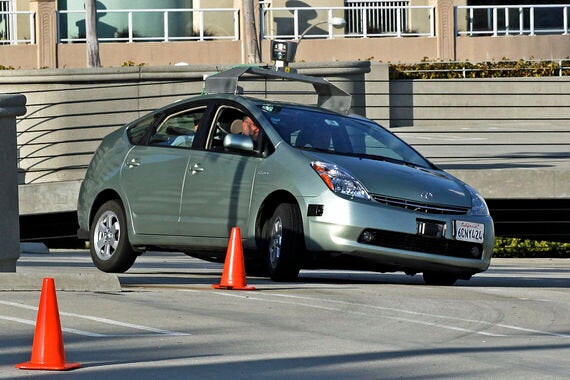Five years ago I made a memorable visit to see Professor Alberto Broggi and his team at the University of Parma who had - using hours of footage from cameras mounted on the front of cars - trained computer systems to recognise kerbs, white lines, parked cars and even pedestrians. Sitting in the back of his demonstration car, I was concerned to see my driver climb into another car and drive off. What I had not expected was for my car, the driver's seat still empty, to follow it- steering itself and maintaining perfect distance from the car in front.
Jump to the present day and it seems I can't go a week without hearing a new update about driverless cars. It's true that their impact will be huge, both from a driver and system perspective. On long journeys, I can't imagine many things better than instructing my car to join a convoy so I could take a break, make phone calls, eat, sleep or work.. And with a system of autonomous cars, my congested commute could become a thing of the past as traffic management systems control the speed of my car, its spacing from the cars around it and even the route it takes home, making the whole network more efficient. Anyone can see the appeal.

Credit: Steve Jurvetson, Flickr
But, much as the frontrunner of wearable tech Google Glass has proved, there is a difference between a proof of concept and a ubiquitous life-changing product. Despite my driverless passage at the University of Parma, I believe hands-free driving may be further off than some of the enthusiastic technologists would have us think. We have made impressive advances enabled by new sensors and improved processing power but we're just not 100% of the way there technologically.
Thanks to the work of Professor Broggi and others, computers are getting very good at the specific skills like braking to avoid hitting another car, but a broader awareness requires intelligence, and human intelligence still outperforms artificial intelligence by a long way. On encountering a graffitied sign or a broken traffic light we can draw on experience as well as intelligence to respond; machines are not so good with dealing with uncertainty or totally new situations.
What's more, we do not know very much about how our brains conduct everyday tasks such as navigation. At last many scientists are realising that we need to know more about cognition if we are to improve automation, a field in which the Royal Institute of Navigation has taken a particular interest.
Understanding this will not only help develop autonomous systems but also help us tackle issues where human meets machine. We've all been in the car when the satnav goes haywire haven't we? Or was the problem the driver not knowing how to use it? Even automatic systems have humans involved somewhere in the loop. Providing systems and information that are free from both human and computer error is not easy. Bigger system issues such as security also need to be addressed. Autonomous vehicles will have communications and computer systems and will be prone to hacking. I for one would not feel comfortable entrusting my life or those of my loved ones with a driverless car until the security is absolutely watertight. It's not just leaked photos that are at risk here, the stakes are much higher.
On a system level, a transport network made up of driverless cars will be very different from the road networks we know today; it will take time and investment to make our roads autonomous vehicle friendly. And that's assuming we all opt for driverless 100% of the time. I may not like the tiresome commute but don't think I would give up the freedom and enjoyment that driving often offers so readily. The reality is much more likely to be a 'mixed modes' approach allowing cars both with and without drivers on our roads. This will mean autonomous vehicles will have to respond to unpredictable cyclists, pedestrians and human drivers enjoying themselves: a big ask.
Currently, the open road is a world too complicated for driverless cars. As such, autonomy is likely to appear first in more controlled situations such as driverless convoys for goods traffic in segregated lanes. Commercial benefits for logistics and haulage will be the driving force in overcoming the remaining technical and regulatory problems, not the "wow" factor of having no driver. The novelty value of an autonomous private car is unlikely to unlock the investment needed to create a transport system of driverless vehicles.
Later this month, the Royal Institute of Navigation will bring together many people striving to make driving safer and ease the burden on the driver at the International Navigation Conference. We are getting closer to seeing driverless vehicles but we should not be fooled in to thinking that because the existing technology is so clever driverless cars are only a year or so away. The fact is, despite its many faults, the existing transport system of individual cars, each with a fallible driver, will be a tough act to follow. And for those who want to eat, read or snooze through the rush hour, there is always the train...
